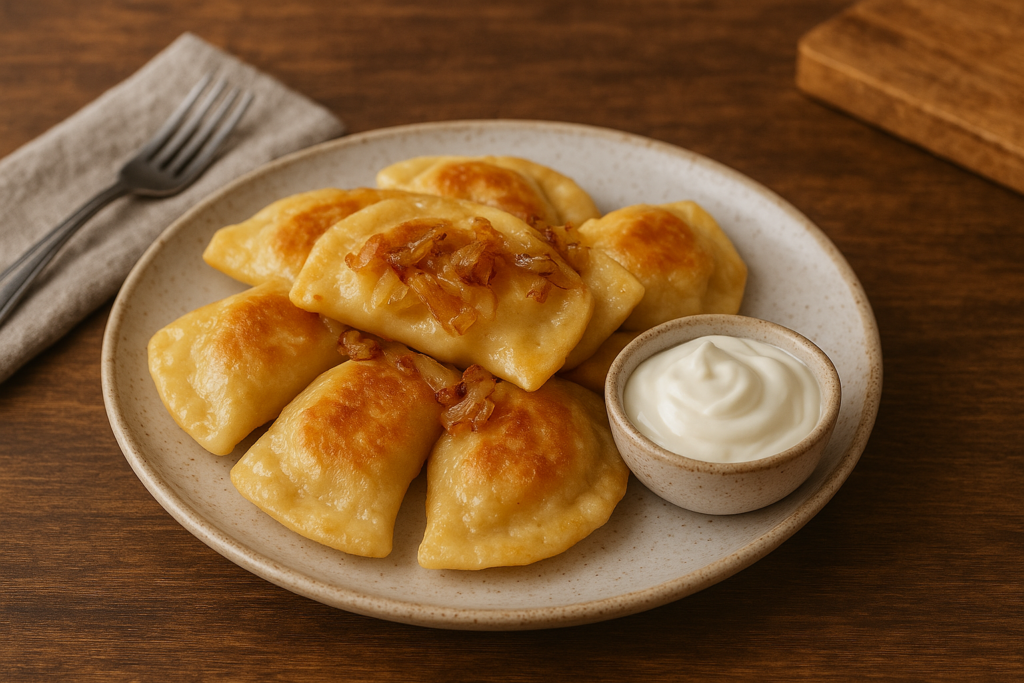25, Sep 2025
What Are Pierogies

What Are Pierogies and Why Everyone Is Talking About This Comfort Food Classic
What are pierogies? At first glance, they’re half-moon dumplings filled with savory or sweet fillings. But beneath their doughy shell lies a culinary story that has traveled through time and culture. To really understand them, we need to look at their origins and the traditions that keep them alive today.
What are pierogies and where did they come from
Pierogies are most closely tied to Eastern Europe, especially Poland, where they’re considered a national dish. The first written records of pierogies appear in Polish cookbooks from the 17th century, but the dish itself likely traveled from Central Asia or the Middle East centuries earlier. Food historians often debate whether pierogies were inspired by Chinese dumplings, Italian ravioli, or Turkish manti, but what’s clear is that they found a permanent home in Slavic cuisine.
Traditionally, pierogies were made in peasant kitchens. Farmers and families created them using simple, affordable ingredients like flour, potatoes, and cabbage. These ingredients were both filling and inexpensive, which made pierogies an essential food for working households. Over time, pierogies became more than just sustenance—they evolved into a food of celebration, made in bulk for weddings, holidays, and harvest festivals.
As migration spread, so did pierogies. When Polish and Ukrainian families moved to North America, they brought their recipes with them. Cities like Pittsburgh, Chicago, and Toronto became pierogi hubs, where the dumpling transformed from a humble peasant dish to a beloved comfort food for people of all backgrounds.
How did pierogies become a symbol of comfort food
Pierogies carry nostalgia in every bite. For many families, they’re tied to childhood memories of grandparents rolling dough in warm kitchens. This connection to heritage has helped pierogies endure across generations. They’re more than just a meal—they’re edible memory keepers.
Part of their comfort comes from their adaptability. A pierogi can be filled with whatever ingredients you have on hand: mashed potatoes, cheese, mushrooms, or fruit. That flexibility made them a survival food in hard times, but also a delicacy when ingredients were plentiful. The act of sitting together, folding pierogies as a family, has also cemented their role as a food of togetherness.
In North America, pierogies have been embraced far beyond Eastern European communities. They’re served in diners, at sporting events, and even at food trucks. The familiarity of mashed potato filling wrapped in soft dough makes them universally comforting, a dish that bridges cultural divides while feeling homegrown to anyone who tastes them.
What are the most traditional pierogi fillings
The classic fillings usually reflect what was available locally. In Poland, ruskie pierogi are filled with potatoes and farmer’s cheese, a creamy, tangy staple. Another beloved version is filled with sauerkraut and mushrooms, especially common around Christmas Eve, when meatless meals are served for Wigilia, the traditional feast.
Sweet pierogies are also common. Cherry, plum, and blueberry fillings make appearances in summer months, often topped with sugar or cream. These sweet versions turn pierogies into desserts, proving their versatility across the meal spectrum.
In more modern settings, pierogies have been filled with spinach, meat, lentils, or even chocolate. This evolution shows how pierogies continue to adapt to modern palates without losing their traditional roots.
How do pierogies compare to other dumplings around the world
It’s fascinating to see how cultures across the globe came up with similar ideas: wrap dough around filling and cook. Chinese dumplings, Italian ravioli, and Japanese gyoza all share DNA with pierogies, but each has its own twist. For instance, ravioli are boiled but often served with sauces, while pierogies are boiled and then pan-fried with onions and butter for extra flavor.
Pierogies are heartier than gyoza and typically larger than Chinese dumplings. Their fillings lean toward starchy and comforting ingredients, unlike spiced meat fillings common in other dumplings. This makes them unique in how they prioritize earthiness and warmth over bold flavors.
Yet the similarities are striking: dumplings everywhere embody comfort and practicality. Pierogies hold their place in this global family of dumplings, showing how a simple cooking technique can reflect so many different cultures.
What role do pierogies play in Polish culture and beyond
In Poland, pierogies are woven into traditions. They’re cooked for weddings, religious holidays, and community festivals. Making pierogies is often a family activity, with generations gathering to roll, fill, and seal dough together. They represent community and togetherness as much as sustenance.
Pierogies also carry symbolism. Their half-moon shape has been tied to harvest cycles, fertility, and good fortune. Many families believe that sharing pierogies during holidays strengthens bonds and brings luck for the coming year.
Globally, pierogies have become ambassadors of Polish culture. Pierogi festivals are held in North America and Europe, celebrating not only the food but also folk music, dance, and crafts. Through these events, pierogies serve as cultural storytellers, preserving heritage while inviting outsiders to join in.
How are pierogies made step by step
Making pierogies at home is a rewarding ritual. It begins with a simple dough: flour, eggs, water, and a pinch of salt. The dough is rolled thin and cut into circles. Each circle becomes a canvas for the filling—whether potato and cheese, sauerkraut, or fruit.
Once filled, the dough is folded into a half-moon shape and pinched closed, sealing in the filling. This step requires care, as leaks can cause the pierogi to burst while boiling. Families often compete to see who can pinch the neatest edges, turning the process into a craft as well as a necessity.
The cooking is straightforward: pierogies are boiled until they float, then often pan-fried in butter with onions until golden. Served with sour cream or fried bacon bits, they deliver a perfect balance of soft dough and crisp edges.
What variations of pierogies exist today
Modern chefs have embraced pierogies as a blank canvas. In trendy restaurants, you’ll find pierogies filled with goat cheese, caramelized onions, or even pulled pork. Vegan versions swap in dairy-free cheese or mashed beans for plant-based eaters.
Regional twists also abound. Ukrainian varenyky are close cousins to pierogies, while Slovak pirohy use slightly different dough. Each country puts its own spin on the dumpling, making pierogies part of a larger Eastern European food network.
Even frozen pierogies in supermarkets have evolved. Once limited to potato and cheese, they now feature flavors like jalapeño cheddar or breakfast-style eggs and bacon, proving that innovation continues even in the freezer aisle.
What are the health benefits and nutrition of pierogies
Pierogies are hearty, but that doesn’t mean they’re unhealthy. Potato and sauerkraut fillings deliver fiber, vitamin C, and probiotics, while cheese provides protein and calcium. When made at home, pierogies can be balanced with whole-grain flour or vegetable-based fillings.
Of course, moderation matters. Fried pierogies loaded with butter and bacon tip the scale toward indulgence. But boiled pierogies with lighter toppings like yogurt or sautéed vegetables can be a wholesome meal.
For plant-based eaters, pierogies offer endless possibilities. Lentil, spinach, or mushroom fillings provide rich nutrition, making pierogies adaptable to modern health-conscious lifestyles.
Where can you find the best pierogies today
If you’re craving authentic pierogies, Eastern European restaurants are your best bet. In cities like Pittsburgh and Toronto, pierogi festivals draw thousands eager to taste dozens of varieties. These gatherings showcase both tradition and innovation.
Grocery stores also stock frozen pierogies, making them accessible for everyday meals. While they may lack the hand-made charm, they’re a quick entry point into the world of pierogies.
Food trucks and modern bistros have also embraced pierogies, often reimagining them with gourmet fillings. From kimchi pierogies to truffle-infused versions, today’s food scene proves that pierogies can keep evolving while staying true to their roots.
What makes pierogies timeless in modern cuisine
Pierogies endure because they balance tradition and adaptability. They remind us of family kitchens, yet they also thrive in innovative restaurants. This dual identity keeps them relevant across generations.
They also embody simplicity. At their core, pierogies are flour, water, and filling—yet they deliver endless possibilities. That combination of accessibility and creativity makes them timeless.
As global cuisine becomes more interconnected, pierogies continue to serve as cultural ambassadors. They hold their place among the world’s great dumplings, proving that comfort food truly knows no borders.
Conclusion
What are pierogies if not proof that the simplest foods carry the biggest stories? They’re dumplings, yes, but also cultural bridges, comfort food, and creative canvases for generations of cooks. From peasant kitchens in Poland to food trucks in North America, pierogies have shown us that a little dough and filling can mean so much more.
FAQ About What Are Pierogies
Are pierogies the same as dumplings?
Pierogies are indeed a type of dumpling, but they’re unique to Eastern Europe, especially Poland and Ukraine. Unlike Asian dumplings or Italian ravioli, pierogies are often filled with hearty ingredients like potatoes, cheese, or sauerkraut and then boiled before being pan-fried with butter and onions.
What is the difference between pierogies and ravioli?
The main difference lies in origin and preparation. Ravioli are Italian and usually served with sauces like tomato or cream. Pierogies, on the other hand, are Slavic, boiled first, and often topped with sour cream, fried onions, or bacon. The fillings also differ—ravioli lean toward cheese and meat, while pierogies favor potatoes, cabbage, or mushrooms.
Can pierogies be sweet?
Yes, pierogies can be sweet as well as savory. Traditional dessert pierogies are filled with fruits such as blueberries, cherries, or plums, and sometimes sweetened cheese. They’re often topped with sugar, honey, or cream for a delightful treat.
Are pierogies healthy?
Pierogies can be healthy depending on how they’re made. Boiled pierogies with lighter fillings like sauerkraut or spinach offer fiber, vitamins, and minerals. But when fried in butter and topped with bacon or cheese, they shift toward indulgence. Moderation and smart filling choices make them a balanced option.
Do pierogies always have to be homemade?
No. While homemade pierogies are special, frozen ones from grocery stores are widely available and convenient. They’re a great way to enjoy pierogies without the time commitment of making dough and fillings from scratch.
Where can I try authentic pierogies?
Authentic pierogies can often be found in Eastern European restaurants, community festivals, or specialty bakeries. Cities with strong Polish or Ukrainian communities—like Pittsburgh, Chicago, Toronto, and New York—are especially known for great pierogi options.
Why are pierogies so popular worldwide?
Pierogies have universal appeal because they’re simple, filling, and comforting. They can be customized endlessly with different fillings, making them adaptable across cultures. Their ability to blend tradition with creativity has turned them into a global comfort food.
- 0
- By Pankajatray
- September 25, 2025 08:06 AM

